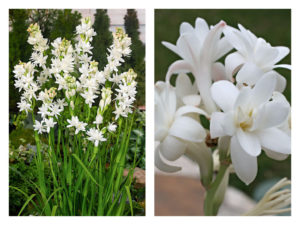Tuberose
* Common name: Tuberose
* Botanical name: Polianthes tuberosa
* What it is: Tuberose is a frost-tender small bulb (technically a rhizome) that blooms for a few weeks in August and September with some of the most fragrant flowers of any plant. Flowers are white (with a pink version) and trumpet-shaped while the foliage is green and grass-like.
* Size: Flower spikes poke up about two feet above the grassy foliage clumps.
* Where to use: Since these are annuals, tuberoses are ideal for pots or in sunny flower beds in the same setting you’d plant zinnias, marigolds, or petunias. Either way, use them in a high-traffic area to take best advantage of the sweet scent (patio, along a walk, next to a door or window, etc.)
* Care: Plant bulbs two inches deep and six inches apart outside in the ground or in pots four inches apart after all danger of frost (mid to late May). Get a jump on the season by starting bulbs inside in pots about four weeks before then, then planting out when the plants are up. Keep soil damp but never to the point of being soggy. Fertilize once or twice during the growing season with a balanced, granular flower fertilizer.
Cut off flower stalks when bloom finishes, then cut foliage after it yellows or dies back with the first frost in fall. At season’s end, dig and dry bulbs, then store them inside over winter in a cool, dry spot in peat moss, sawdust, or sand if you want to keep them from year to year. Otherwise, let the bulbs freeze and rot in the ground and plant new next spring.
* Great partner: Pair with purple or pink petunias or blue scaevola in a pot. Or plant clusters around the base of dwarf porch or patio shrubs, such as shrub roses, boxwoods, or yews.








